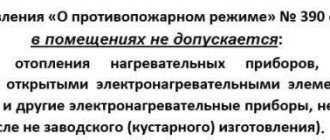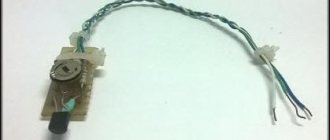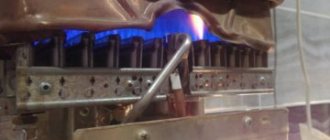Exhaust systems with carbon filtration have become especially popular in recent years. This demand is based on the fact that developers are increasingly giving preference to studio apartments, where the living room is combined with a kitchen.
In this case, it will not be possible to do without a good exhaust system. Conventional filters installed in the hood will cope with this task perfectly.
In order for the airspace to be cleaned efficiently, it is necessary to regularly change the coal. If necessary, you can replace the carbon filter for the hood with your own hands.
Purpose of a carbon filter
Almost all modern kitchen hoods are equipped with a filtration system. Coal cassettes in such a system are located under the grease trap. They are usually made in a round or rectangular shape.
Performance characteristics of the universal filter:
- used many times, needs to be changed frequently;
- facilitates cleaning of the hood body and air outlet;
- prevents grease from penetrating the motor and other important parts of the hood;
- filters coarse waste, which is easily sucked into the structure by a fan;
- Helps protect equipment from damage.
Cleaning nets are made of synthetic material. Components made of aluminum or padding polyester should be replaced up to 4 times a year.
Modern models of exhaust systems independently notify the owner with a signal that it is time to replace the coal. Metal mesh cannot cope with foreign odors; for this, a special carbon layer is used.
Activated carbon systems can regularly eliminate kitchen odors for 3 months straight. Rectangular, round or square cassettes are filled with activated carbon.
The granules are quite dense, they actively absorb any odor in just 5 minutes. Only the internal beads of the cassette should be replaced.
Characteristics of hoods with carbon filtration:
- eliminating odors in the kitchen during cooking;
- rapid air purification;
- replacing components every season;
- The presence of a grease trap and carbon filter ensures complete protection of the exhaust system.
If it is not possible to select a comparable cassette for a specific hood model, it is better to use universal accessories. However, such cleaning will not always be of high quality.
Types of filter elements
First, you need to understand why you need a grease filter for your hood in the first place, so that you don’t have the temptation to get rid of it, supposedly so that it “draws better.” This applies to disposable items that must be replaced frequently. And they are needed to protect the fan motor from sticky greasy deposits getting inside, which will cause the unit to fail very quickly.
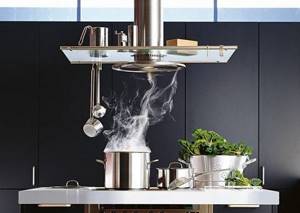
The same sticky substance will cover the inside of the air ducts and walls of the shaft. Not only will they themselves begin to emit an unpleasant odor, but they can also become a hotbed for harmful microorganisms and food for cockroaches. This is prevented primarily by a grease filter for kitchen hoods, installed on all devices without exception. But the presence of the second type of elements - coal depends on the type of household appliance, which are:
- direct-flow;
- recirculating.
Direct-flow hoods are mainly hoods without a carbon filter, since they do not require one. The fan captures contaminated air and throws it into the exhaust shaft, from where it comes out under the influence of natural draft. Recirculation units do not require a shaft, since after purification they return all the air back into the room.
Important. When using a direct-flow type household appliance for exhaust hood in the kitchen, care should be taken to organize the flow of air from outside into the house
To do this, just open the window slightly or set the plastic window sash to ventilation mode. Otherwise, odor removal will be ineffective.

Recirculation hoods are equipped with a grease and carbon filter. The first traps fats, the second produces fine air purification. Carbon elements come in different configurations, but work the same way: the air mixture passes through a layer of activated carbon granules. This creates additional resistance in the flow path, which can be solved by using more powerful fans.

But filters that retain fat particles come in different types:
- disposable grease filter. Once contaminated, this element must be replaced; it cannot be restored by washing;
- perforated aluminum filters. They are in mid-price range hoods and can be cleaned by washing;
- mesh and perforated stainless steel elements. The most expensive cleaners, but they are durable and easy to regenerate (clean).

Scope of application of carbon filters
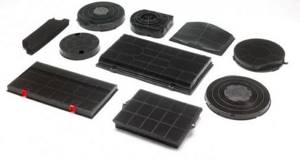
Carbon filters are actively used not only in kitchen hoods; several types of similar equipment are produced:
- Window - mounted on the window frame and opens only when necessary.
- Main - designed to obtain purified air in country houses. Installation is carried out in a general ventilation system. Trunk models with coal are often installed in industrial premises to make point connections.
- For the exhaust system - used in the kitchen in the exhaust system to eliminate extraneous odors during cooking.
The use of carbon filtration is especially common in kitchen exhaust systems.
Such systems operate on the recirculation principle, since in addition to removing fat and soot, the air in which the smallest particles float must also be purified.
Coal performs its tasks especially well, eliminating not only odor, but also deeply purifying the air. The property of the filler allows not only to eliminate odors, but also foreign small particles.
Coal models are actively used not only in everyday life, namely in the kitchen, they are also installed in private houses or cottages as smoke extractors.
Large houses are often equipped with fireplaces or small boiler rooms, which provoke the release of carbon monoxide; only coal cleaning can effectively combat this.
During low-rise construction, ventilation ducts for cleaning equipment are not always installed. As a result, an autonomous highway is installed that stretches through all the rooms of the house.
You should monitor the cleanliness of the air not only in your home, but also in your workplace. In the industrial sector, cleaning devices are divided into 2 types:
- mesh - can self-clean, equipped with an irrigation method;
- preliminary - electrostatic deep type and fine-fiber, dry.
To normalize the operation of the entire ventilation system in industrial premises, a special filter should be installed for the air pressure regulator.
In the main line, it will help reduce air pressure and maintain it in the optimal range.
Air Purifier Options
First of all, you should understand that its design also depends on the conditions in which and for what purposes the air purifier will have to be used. For example, if the room has normal humidity, but dust is flying in the air, then you can remove it by making a cleaner from a car filter, as in this video.
Air purifier for dry rooms
In rooms with low humidity, in addition to cleaning from dust, it is necessary to raise this humidity to values at which a person will feel more comfortable, namely up to 40-60%.
A simple device for these purposes is easy to assemble yourself, and it will consist of a plastic container and a computer cooler. This is done simply.
- Cut 2 holes in the lid of the container: one for the fan, the second for air outlet.
- Screw the cooler to the lid using self-tapping screws.
- Connect the fan to a 5V phone power supply or a specially purchased 12V power supply. In the second case, the cooler speed will be higher and, accordingly, the unit’s performance will increase.
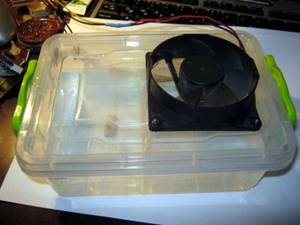
- To better clean the air from dust, you can stretch several rows of fishing line inside the container across the air movement and hang microfiber napkins or any dense fabric on it so that they do not adhere to the sides of the tank, and the air can pass to the exit. A significant portion of the dust in the air flow will settle on damp cloth and water. If outlet holes are drilled in the side walls (4 cm above the water level), then the fabric can be hung across the entire width of the container, and it will not obstruct the air flow to the outlet.
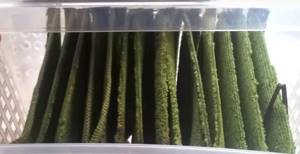
Wet room cleaner
High indoor humidity also brings many problems: the proliferation of pathogenic bacteria, the rapid growth of mold on the walls, damage to furniture and musical instruments, etc. Also, high humidity is harmful for the garage, or rather for the car in which you keep it. To dry and clean the air, you will need to use materials that can absorb excess moisture. The simplest material is ordinary table salt.
Before using for these purposes, salt should be roasted in the oven for several hours. Only in this case will it most effectively absorb moisture from the air.
A homemade apparatus for cleaning and drying air is made in exactly the same way as for humidifying, but with minor differences:
- high fan speeds are not required (salt will scatter throughout the container), so charging from a phone with a 5V output will be sufficient;
- Instead of water, a thick layer of salt 3-4 cm is poured onto the bottom of the container.

However, technological progress does not stand still, and a more effective moisture-absorbing material has been found - silica gel. You met it when buying shoes - these are bags of small balls.
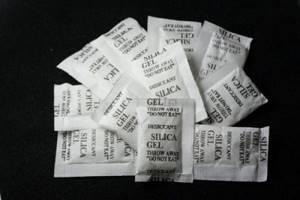
Silica gel is a non-toxic substance consisting of silicon dioxide.
Caution should be exercised if there are small children in the home. Make sure your child does not eat this substance as it may contain cobalt chloride, which is poisonous if ingested.
Silica gel can be bought in different packaging in Chinese online stores. The advantage of this product over regular salt is that for the unit to operate effectively, a significantly smaller amount is required.

Some types of silica have a special color, as shown in the following photo.
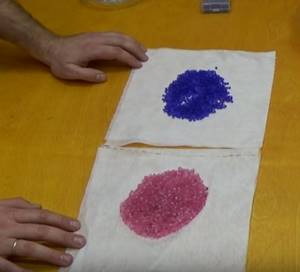
This dye acts as an indicator: when the crystals are dry, it is blue, but when the substance absorbs maximum moisture, it turns pink. To restore the crystals, they are placed in the microwave for 8 minutes at the lowest power. Based on these data, silica gel works more effectively in devices that purify the air from moisture.
Design and principle of operation of a carbon filter
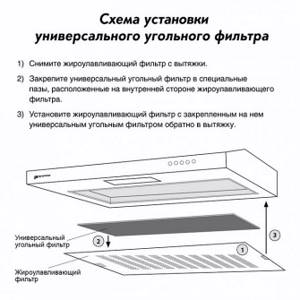
Externally, hood filters are not much different from each other; in fact, they are an ordinary mesh. It is not always easy to make a choice which cleaning model in the system will be effective, because there are quite a lot of manufacturers on the market.
When choosing, it is better to focus on reviews and ratings of hoods; in addition, you can build an air filter with your own hands. It is worth listing several points that the equipment should have:
- resistance to high temperatures;
- no distortion on the outer casing;
- compatibility with the hood design.
The heat resistance cannot be less than 70 degrees Celsius, otherwise there is a chance that the parts will simply begin to melt.
Compatibility will affect the quality of operation of the entire exhaust system, because if the filter does not fit well, then cleaning may not be carried out efficiently.
The carbon filter has a fairly simple principle of operation; its main task can be called cleaning the air space from foreign odors. This type of filtration completely recycles the air.
In the design, the first layer is a filter to catch grease, which performs the first stage of cleaning, and after it, coal begins to work, which completely processes the air and releases it cleanly to the outside.
How high the performance of the device will depend on the density of the internal element. It is important to understand that the carbon layer should be changed regularly, otherwise cleaning will be useless.
Manufacturers usually prefer to use familiar carbon as an internal filter component. This substance perfectly processes the air in full and releases it outside.
For high-quality operation of the exhaust system, the coal should be replaced once every few months. Modern models are equipped with a special sensor that will indicate that the filter should be cleaned or completely replaced.
If we explain the entire cleaning system in simple words, we can say that grease filters do the dirtiest work. Small particles, fat, carbon deposits and soot are retained in the mesh.
This way the internal parts of the hood and its body will be protected from damage. There are several types of such barriers:
- disposable;
- reusable.
Disposable models are made of acrylic or non-woven fabric, reusable ones will be made of steel or aluminum. Coal barriers are aimed exclusively at air treatment, purification and release to the outside.
Carbon filters have some interesting features. Firstly, the device has a sorption basis.
These elements must completely purify the air in the kitchen, eliminating impurities of gas, steam, foreign odors and other harmful particles. Before installation, activated carbon is treated with a special chemical composition.
It is this treatment that allows you to completely absorb all foreign odors. In order for the carbon filter to work efficiently and for a long time, it is important to promptly replace it with a new one.
Designs with two barriers are especially common, but there are also hoods that purify the air exclusively using a carbon filter. It is worth saying that the cost of such exhaust systems is much lower than double-barrier ones.
However, if there is no grease barrier, the activated carbon filter will have to be changed much more often, as it will quickly become dirty.
This will lead to the fact that the functions are limited to eliminating odors, but soot and greasy deposits will accumulate on the body of the exhaust system.
Required parts and tools
What you will need to assemble the carbon filter:
- air filter from a car (we use a filter for a GAZ car);
- Activated carbon;
- galvanized flange with a diameter of 100 mm;
- washers, nuts, rivets;
- drill with 4 mm drill bit;
- jigsaw, soldering iron, metal scissors.
The choice of an air filter for a car is due to the fact that it already contains the mesh we need, which greatly simplifies the task of creating a carbon filter.
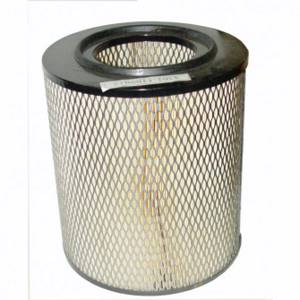
How to make a carbon filter with your own hands
Sometimes it happens that the hood still works great, but its model is outdated and it is not possible to purchase cassettes for it, due to the fact that they are simply no longer produced. Don’t despair, because you can make a carbon filter for ventilation yourself.
First of all, you need to open the housing, this is done along the joint seam. The recycled carbon filler is cleaned and replaced with a new one.
The main condition remains a similar coal formula; usually granular or powdered is used. You can find universal filtration on sale. However, this does not mean that the product is original.
Why coal
Now let's talk about how to make a carbon filter for cleaning moonshine with your own hands - naturally, we take as a basis the fact that you already know how to brew an alcoholic drink and know how to make it from high-quality and natural products.

However, as practice shows, creating this drink is not difficult, but preparing it for use is a whole science.
Activated carbon is an ideal cleaning product due to its high porosity. Thus, it is an excellent adsorbent. However, it should be remembered that pores can only adsorb molecules of a certain size, and therefore it is so important to correctly select a specific activated carbon that can effectively solve the problem.
While activated carbon was previously made from cattle bones, today it is mostly made from wood. Which is better, since the pores of the charcoal from the bones weakly adsorbed additives and fusel oils. But wood would be an ideal option, but it contains additional impurities:
Such additives can negatively affect the taste of alcohol - it will be bitter and tart. So this option is not suitable either!
But don’t despair – the activated carbon you need is present:
Specialized coal created for distilleries is also suitable - these are the following brands:

Having carefully studied all the listed types of purifier, we note that you should not take fillers from water filters, since they contain ion exchange resins. It’s also better not to take gas masks - are you sure that you haven’t used it and it hasn’t accumulated harmful substances? Therefore, there is only one option left: to use specialized products, that is, BAU-A coal, for the production of which birch is used. Moreover, it is inexpensive.
Some “craftsmen” want to save money and burn birch or beech themselves. But it’s far from a fact that they make an ideal cleaner - after all, wood burns along with oxygen. Therefore, we recommend that you still spend money and buy a specially prepared product.
How to clean
The video will clearly demonstrate how to make a carbon filter for moonshine with your own hands. But we will definitely describe the process so that you definitely don’t have any questions on this topic.
Currently reading
Where to put the “heads” after distillation
3 recipes for raspberry tincture
So, there are two different approaches:
Let's look at each method in more detail so that you can understand which one is more suitable for you than others.
How to make a carbon filter with your own hands
There is nothing complicated in creating a special device for removing impurities and fusel oils:
The volume of coal used depends on its brand and the amount of moonshine. If you use BAU-A, then for every liter of alcoholic product you make, you should use up to twelve grams of the substance.
By the way, before adding filter material, rinse it with clean drinking water - this will help wash away dust and prevent the hardness of your drink.
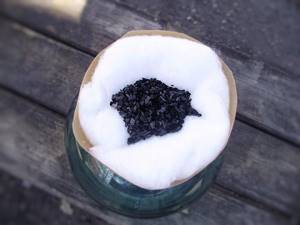
Some people do it differently - they use a household filter jug and simply pass the product through it. To achieve the desired result, moonshine must be poured through the jug at least five times. Or until the desired taste of the drink is achieved.
Experienced moonshiners create almost industrial installations in this matter. But their construction requires not only time, but also additional costs. For example, you will need an aquarium pump and other components. Which will result in a large final sum. And there is no particular point in such investments.
The simplest filter is carbon in moonshine
Perhaps this method is even more primitive than the one described above. To implement it you need:
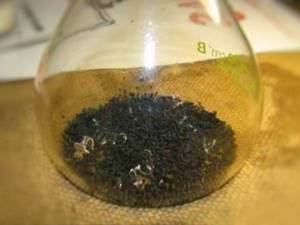
However, this method, according to some, is not the most effective. This is due to the fact that the purifier adsorbs pollutants and impurities only for the first two hours, and then only releases what it has accumulated. That is, there is no point in waiting so long - two hours of insistence will be enough. And then, after filtering, the procedure can be repeated.
Do not rush to throw away used coal. It can be restored - pour it with a 2% solution of ordinary hydrochloric acid, rinse it with clean, running water, dry it and bake it over a fire or in the oven, but always in a sealed container. This will restore adsorption.
Filter replacement rules
In order for the hood to function properly, it is necessary to regularly care for its metal components when the anti-odor filter is dirty.
If the hood is not equipped with a signal indicator that determines the level of contamination, then the condition of the filters can be assessed during inspection, as well as by air quality.
Washing and replacing filters is quite simple; it is only important to follow the step-by-step plan:
- the decorative panel should be removed and the filter itself should be removed;
- A dishwasher will help clean the parts; you can also wash them manually (but only after soaking them in a cleaning agent to remove grease);
- All that remains is to dry the filter and mount it in place.
In the case when a washing machine is used to wash filters, the procedure should be carried out once every 2 months, manual cleaning is carried out once a month.
To clean the carbon filter, you should use a vacuum cleaner. If the coal is lost, it should only be replaced.
Filter replacement is carried out according to the following scenario:
- the hood should be de-energized;
- the grease filter should be removed;
- the carbon filler is removed;
- the cassette is filled with new coal;
- After assembly, you should turn on the hood and check its operation; there should be no questionable noise or vibration.
Reviews from experienced housewives
Housewives often share their impressions of using kitchen hoods, the effectiveness of the filters installed in them, and their experience of caring for them. Experienced housewives advise that when purchasing, you should immediately find out all the nuances: “We chose it together with my husband. He asked the consultant a lot of questions, but he purchased an excellent hood—Electrolux. It’s equipped with a carbon microfilter, so I didn’t have to buy anything else.”
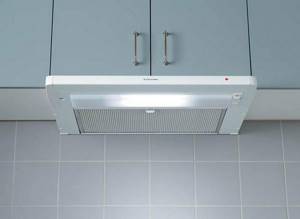
Kitchen hood Electrolux
No recommendations will help as much as the reviews of those who have already tried all the methods of filter care:
- “I wash the metal filter only in the dishwasher. Cleans up perfectly."
- “I use oven cleaner. I smear the filter with a brush, let it sit for 20 minutes, then wash it off, rinse and wipe it off.”
- “I have an inexpensive Scarlett hood. Once a month I always wash the filters and clean the chimney outlets. I use Mr. Muscle spray. There is no greasy residue either on the furniture or on the ceiling. I think that it’s all about proper care, not the cost of the hood.”
- “I discovered that the filter was so clogged that no amount of cleaning would help, and there was nowhere to buy a new one. My husband found a way out: he cut out 2 rectangles to size from thin foam rubber, crushed charcoal and placed it between them. It’s been in service for a month now.”
Now you know the basics about filters for kitchen hoods and can choose the most effective option for yourself.

